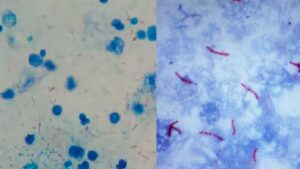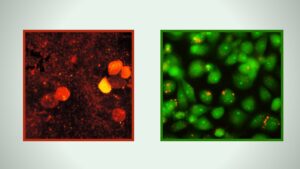Fungi are eukaryotic and contain well-organized nuclei. The fungal nucleus is membrane bound and consist of two membranes of characteristic pores, a nucleolus and chromatin strand that becomes organized into chromosome during nuclear division.
The fungal nuclei are extremely minute, therefore study with the light microscope is very difficult. The cells of fungal hypae are either homokaryotic, with genetically identical nuclei or heterokaryotic with genetically different nuclei, in other words, showing the phenomenon of heterokaryosis.
Aim
To study the detailed morphology of nuclei and number in filamentous fungi.
Principle for Nuclear Staining of Filamentous Fungi
Location and enumeration of fungus nuclei are made by the use of a variety of fixatives. Fungal nuclei are most often stained with hematoxylin, Giemsa, Feulgen or carmine.
Requirement
- Living fungal culture
- Giemsa Stain
- Phosphate buffer 6.9pH (Note: Mix 45 ml NaH2PO4 0.2M with 55ml of Na2HPO4 0.2M)
- Ethyl Alcohol (70%, 90%)
- 1N HCL
- Lactic Acid
- Euparal
- Distilled water.
- Clean grease-free glass slide
- Sterile Petri plate
- Wash bottle
- Transfer needle.
- Bunsen burner
- Water bath at 60-degree centrigrade.
- Microscope.
Procedure for Nuclear Staining of Filamentous Fungi
- Grow the fungus on thin agar film on new glass slides in a Petri dish lined with moist filter paper (aseptic conditions).
- Fix spores and mycelia for 10–12 minutes (in a 3:1 mixture of ethyl alcohol and acetic acid or in a 3:1:1 mixture of ethyl alcohol, acetic acid and lactic acid).
- Rinse the preparation in 95% ethyl alcohol.
- Transfer the preparation in 70% ethyl alcohol (it can be stored for several days before staining).
- Rinse in distilled water.
- Submerge the preparation for 5 minutes in 1N HCl at room temperature.
- Transfer it to 1N HCl at 60°C and keep for 7 minutes.
- Rinse first in water and then in phosphate buffer (pH 6.9), 5 changes in each.
- Transfer the preparation in dilute Giemsa stain (1 mL stain in 15 mL phosphate buffer at 6.9 pH) and stain for 2 hours
- Rinse in phosphate buffer.
- Rinse in distilled water.
- Allow the preparation to air dry at room temperature.
- Mount in euparal.
- Cover the preparation with a cover slip.
Observations
Observe the slide under a microscope by using high-power oil immersion objectives. Examine the colour and number of nuclei in spores and hypal cells
Result
- Nuclei: Rose to pink.
- Cytoplasm: colourless or light blue zone surrounding the nuclei.



